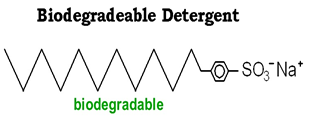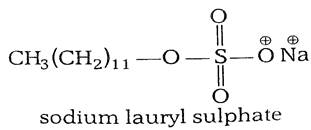What are biodegradable and non-biodegradable detergents? Give one example of each.
It has been found that the detergents having a great deal of branching in the hydrocarbon tail are not biodegradable and cause pollution in rivers and waterways. This is because the presence of side chains in the hydrocarbon tail stops bacteria from attacking and breaking the chains. This results in slow degradation of detergent molecules leading to their accumulation in water ways. Alkylbenzene sulphonates having branched chain alkyl groups possess poor biodegradability and cause pollution in rivers and water ways. Such detergents are termed as non-biodegradable or hard detergents.

Examples: 
The alkyl sulphates do not possess branching and are therefore biodegradable. They do not cause pollution. Alkyl benzene sulphonates in which the phenyl group is either attached to the end of a long chain alkyl group are also biodegradable and do not cause pollution. These are termed as soft detergents. Nowadays, efforts are being made to keep the amount of branching in the detergent molecule to a minimum. Since unbranched chains are more prone to attack by bacteria, the detergents having no branching or minimum branching are easily biodegraded and pollution is prevented.
Example: Sodium-4-(1,3,5,7-Tetra Methyl Octyl) Benzene Sulphonate